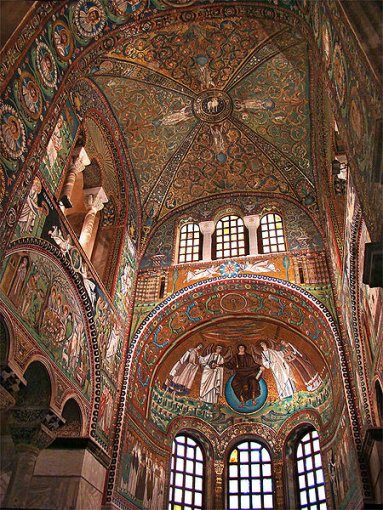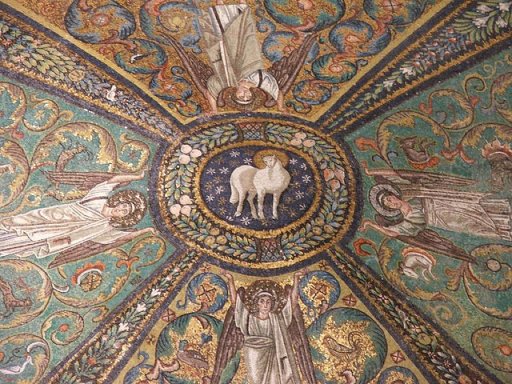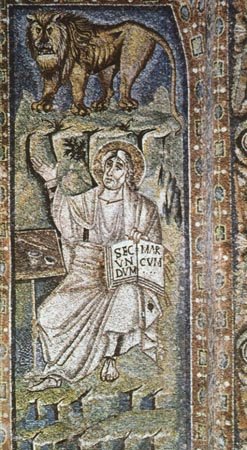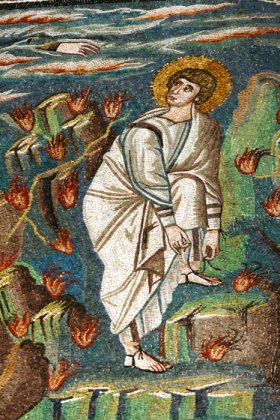|
San Vitale |
|
|
|
|
|
History This wonderful church is called the basilica of San Vitale: basilica in the sense of its importance as a church rather than its shape, which is octagonal. It was built between 526 and 547, and the closest model is probably the Pantheon in Rome. Its form tells us than San Vitale was envisaged as a martyrium to the saint of its dedication. Saint Vitalis was a possibly legendary early Christian martyr who was buried alive: the church is built on the traditional site of his martyrdom. This was a lively time in Italian history. Theoderic died in 526, and the Arian Ostragoths were driven out of Ravenna in 540 by Belisarius, Emperor Justinian's general. As I've mentioned elsewhere, the Arians, under Theoderic and after his death, were tolerant of the Roman tradition of Catholicism, and this was a church of that tradition from its foundation. The Art The mosaics, which date from the earliest years of the church, are found in the sanctuary and in the apse, and the work in the two locations differs greatly in style. The cupola of the main body of the church was frescoed in the eighteenth century: Giuseppe Bovini (Ravenna Art and History) describes this as a 'defect' and says no more about it. Neither shall I. The mosaics in the Apse are often given the label 'Byzantine'. They are stiff, formal, with rigid forward facing figures. The sanctuary mosaics are much more lively affairs, depicting Old Testament scenes. The style is described as 'Hellenistic-Roman' but I'm not entirely sure how useful these labels are in Ravenna, where many mosaics seem to be a synthesis of styles. I'll look at the sanctuary mosaics first. the two lunettes are drawn from Genesis. The first image below shows the story of the three angels, who foretold the birth of Isaac to Abraham (aged 100) and Sarah (a youthful 99), before heading off to deal with Sodom. Abraham is offering them a meal of bread, milk, and a sacrificed calf. On the right is the familiar scene of the sacrifice of Isaac. The second image shows Abel and Melchizedek, offering bread and a lamb to God. These are references to Genesis Ch 4 v 4 in the case of Abel, Ch14 v 18 in the case of Melchizedek. |
|
|
|
|
|
|
|
|
Both scenes demonstrate a familiar
prefiguring of New Testament concerns, the passion of Christ and the the
establishment of the Eucharist; both entirely appropriate for what took
place at the altar below. The narratives feature in a version of the
liturgy of the Eucharist in use for over 1500 years, and still
occasionally used today: 'Be pleased to look upon these offerings with a serene and kindly countenance, and to accept them, as once you were pleased to accept the gifts of your servant Abel the just, the sacrifice of Abraham, our father in faith, and the offering of your high priest Melchizedek, a holy sacrifice, a spotless victim. Now look at the vault above he frescos, and read the continuation of the prayer: |
|
|
|
|
|
We humbly beseech Thee, almighty God, to command
that these offerings be borne by the hands of thy holy angel to Thine
altar on high in the presence of Thy divine Majesty; that as many of us
that shall receive. . . * |
|
|
Just two more mosaics from the sanctuary, showing once again the vitality and realism of the sanctuary mosaics. On the left is St Mark with his wonderfully threatening lion. On the right is Moses, surrounded by a vivid burning bush, removing his sandals as instructed and looking slightly alarmed at the sight of the hand of God coming down from an extraordinary, almost impressionist, sky. |
|
|
|
|
|
If these mosaics teach us anything, it is that such art is not just decoration; it has a function that is integral to its location. Let's now move into the apse. According to some ideas I'll discuss, the mosaics here also have a function, but it is political rather than liturgical. |
|
| *For pointing out this prayer I am grateful, as always, to Frank DeStefano (Giorgione et al.) | |





